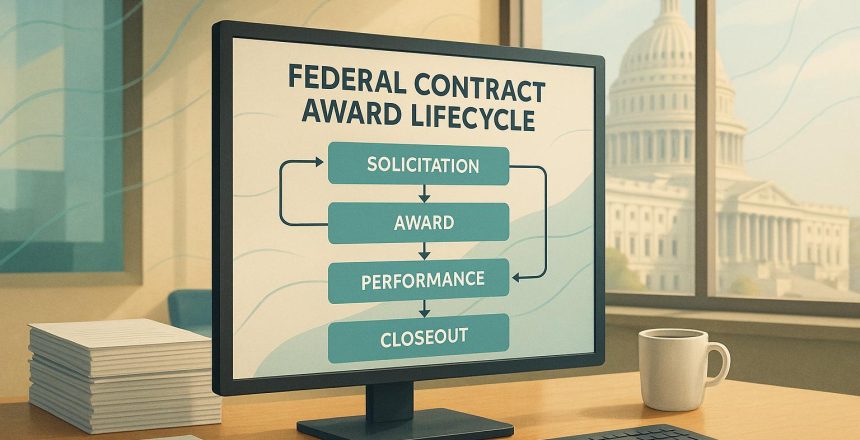The federal contract award lifecycle is how the U.S. government spends over $600 billion annually on goods and services. It’s a structured process with four main phases that businesses must understand to compete for contracts effectively:
- Planning and Research: Agencies assess needs, conduct market research, and define requirements like SOW (Statement of Work) or PWS (Performance Work Statement). Businesses should update their SAM.gov profiles, optimize NAICS codes, and build relationships with government buyers.
- Bid Preparation: Companies craft proposals based on solicitation documents, ensuring compliance with detailed requirements, evaluation criteria, and submission guidelines.
- Bid Review and Selection: Agencies evaluate bids using methods like Lowest Price Technically Acceptable (LPTA) or Best Value Trade-Off, focusing on technical capability, cost, and past performance.
- Contract Management: After award, contractors must monitor performance, maintain compliance with FAR/DFARS regulations, and manage risks like cybersecurity breaches.
Key Insight: Nearly 25% of federal contracts are reserved for small businesses, offering significant opportunities. Success requires preparation, attention to detail, and strict adherence to federal guidelines.
This guide breaks down each phase with actionable steps to help businesses navigate the process confidently.
Understanding the Government Procurement Process
Phase 1: Planning and Research
The first step in securing federal contracts is all about preparation. With federal agencies spending over $759 billion in FY2023 alone, this phase sets the stage for procurement success. It involves detailed planning by government agencies and proactive research by potential contractors.
Agency Requirements
Federal agencies start by identifying their needs through thorough assessments. This process results in key documents that outline the scope and goals of the procurement:
| Component | Description | Key Considerations |
|---|---|---|
| Statement of Work (SOW) | A detailed outline of required goods or services | Includes technical specs, deliverables, and timelines |
| Performance Work Statement (PWS) | Focuses on desired outcomes | Emphasizes measurable performance standards |
| Statement of Objectives (SOO) | Broad, high-level goals for the agency | Ensures alignment with strategic and mission objectives |
"All government procurement begins with either an idea or need by a government agency. The procurement lifecycle starts with market research and determining whether the size of the contract meets the simplified acquisition threshold for a small business set-aside award. It’s important for businesses to get involved in this process early and the best way to do that is by creating relationships with government buyers." – FedBiz Access
Once these requirements are clearly defined, agencies move on to targeted market research to identify qualified vendors.
Market Research Steps
Market research is a critical step for both agencies and contractors. Businesses looking to secure contracts should focus on these key areas:
- NAICS Code Optimization: Federal contracts often prioritize businesses based on their NAICS (North American Industry Classification System) codes. It’s essential for companies to ensure their SAM.gov profiles are up-to-date and accurately reflect their capabilities.
- Capability Assessment: Companies should document their strengths, including:
- Core competencies
- Past performance metrics
- Quality management systems
- Industry certifications
- Risk mitigation strategies
- Relationship Building: Networking is vital. Attending industry events and briefings can provide early insights into upcoming opportunities and help establish connections with government buyers.
This groundwork not only helps agencies identify suitable vendors but also gives businesses a head start in navigating the procurement process.
Contract Types and GSA Schedules
Once agency needs and market research align, understanding contract types becomes crucial. The GSA Multiple Award Schedule (MAS) program plays a significant role here, facilitating over $41.1 billion in spending during FY2023. GSA Schedules streamline the contracting process by enabling federal agencies to purchase goods and services from pre-approved vendors at pre-negotiated prices. In fact, over 75% of these awards went to small businesses in FY2023.
To succeed with GSA Schedules, vendors should focus on:
- Crafting accurate pricing strategies
- Providing clear and detailed service descriptions
- Ensuring regular compliance with federal requirements
- Actively participating on platforms like GSA Advantage! and eBuy
- Marketing effectively to government buyers
Phase 2: Bid Preparation
This phase is all about crafting a bid that not only meets federal requirements but also stands out. It’s a meticulous process that requires strict attention to detail and adherence to the submission guidelines.
Solicitation Documents
Federal solicitations follow a standard format known as the Uniform Contract Format (UCF), which includes 13 sections labeled A through M. To create a competitive bid, you’ll need to fully understand these documents. The table below highlights the key sections to focus on:
| Section | Purpose | Key Elements to Address |
|---|---|---|
| A & B | Basic Information & Pricing | Contract form, CLINs, pricing structure |
| C | Requirements | Statement of Work, technical specifications |
| L | Proposal Instructions | Submission guidelines, format requirements |
| M | Evaluation Criteria | Scoring factors, selection methodology |
When reviewing these documents, concentrate on three critical areas:
1. Technical Requirements
This section spells out exactly what the agency needs. Pay close attention to:
- Performance specifications
- Delivery schedules
- Quality benchmarks
- Compliance standards
2. Evaluation Framework
Understanding how your bid will be assessed is key. Common evaluation criteria include:
- Technical capability
- Past performance records
- Pricing structure
- Risk management strategies
3. Submission Guidelines
This part covers the rules for formatting and submitting your bid. Double-check every detail to avoid disqualification due to non-compliance.
Once you’ve analyzed the solicitation documents, the next step is assembling a submission that meets all requirements.
Submission Requirements
Meeting submission requirements is just as important as crafting a strong proposal. Missing even one detail can cost you the contract.
Registration and Documentation
Ensure you have the following in place:
- Active registration on SAM.gov
- A valid DUNS number
- Necessary certifications
- Past performance records
- Financial statements
Compliance Matrix
Use a compliance matrix to track every requirement. This tool helps you ensure that all technical details are addressed, proper documentation is included, formatting guidelines are followed, and page limits are respected.
"Solicitation means any request to submit offers or quotations to the Government." – FAR 2.101
To improve your chances of success, consider these strategies:
1. Start Early
Begin working on your proposal as soon as possible. This allows time for research, drafting, internal reviews, and final adjustments.
2. Assign Roles
Divide the proposal into sections and assign them to team members based on their expertise. Each person should:
- Fully understand their assigned section
- Document any questions for clarification
- Help with compliance checks
- Contribute to the final integration of the proposal
3. Quality Control
Set up a thorough review process to ensure:
- Technical accuracy
- Valid pricing
- Full compliance with requirements
- Professional editing and formatting
Finally, remember that late submissions are rarely accepted unless there are extraordinary circumstances. Submit your bid well ahead of the deadline using the methods specified in the solicitation.
sbb-itb-8737801
Phase 3: Bid Review and Selection
Scoring Criteria
Federal agencies use two main methods under FAR to evaluate bids:
- Lowest Price Technically Acceptable (LPTA): This method awards the contract to the lowest-priced bid that meets the minimum technical requirements. It’s often used for straightforward procurements.
- Best Value Trade-Off: Here, both price and non-price factors are considered. Agencies may select a higher-priced bid if it offers better technical capabilities or stronger past performance.
Proposals are typically assessed based on core factors like technical approach, past performance, management approach, and price. The weight assigned to each factor depends on the specific solicitation. To stand out, your bid should clearly demonstrate how your solution aligns with the agency’s needs in these areas.
Once the evaluation is complete, the Contracting Officer oversees the final assessment and documentation process.
Contracting Officer Duties
The Contracting Officer plays a central role in managing the evaluation and selection process in compliance with the Procurement Integrity Act (PIA).
Key Responsibilities:
- Proposal Review
The officer reviews submissions against established criteria, including technical capability, past performance, and cost. Strengths, weaknesses, and risks must be documented in the contract file. - Documentation Management
All decisions are recorded in the Business Clearance Memorandum (BCM), which serves as a detailed account of the decision-making process for post-award review.
"Evaluation criteria is also a roadmap for proposal teams. To get the points to add up in your favor, every single thing you write must consider these criteria and be written for the sole reason of benefitting the agency." – Cheryl Smith, Senior Proposal Specialist, Xait
The Contracting Officer is also responsible for safeguarding proposal information throughout the selection process. Disclosing source selection details without authorization can lead to severe consequences, including criminal fines, up to five years of imprisonment, contract termination, and suspension from federal contracting.
If a proposal is found to be "excessively or grossly deficient", the Contracting Officer has the authority to eliminate it from consideration without further review of its cost or price. This underscores the need to submit a thorough and well-documented proposal that addresses all solicitation requirements.
Phase 4: Contract Management
Compliance Rules
Government contractors must navigate a complex web of regulations, including the Federal Acquisition Regulation (FAR), Defense Federal Acquisition Regulation Supplement (DFARS), and Small Business Administration (SBA) guidelines, to stay compliant with federal requirements.
| Requirement | Timeline | Action Required |
|---|---|---|
| Industrial Funding Fee | Quarterly/Monthly | Submit fees via the FAS portal |
| SAM.gov Profile | Annual | Keep registration updated and accurate |
| Executive Compensation | Semi-annual | Report via SAM.gov, if applicable |
| Business Size Status | As needed | Update in SAM.gov before exercising options |
| Employment Verification | Ongoing | Maintain enrollment in the E-Verify program |
Cybersecurity compliance has become increasingly critical, with the average cost of a data breach in 2023 soaring to $9.48 million. This underscores the importance of safeguarding sensitive information while adhering to regulatory standards.
Performance Requirements
Effective contract performance management hinges on detailed documentation, robust quality control, and proactive risk management. Here’s a closer look at these key areas:
Documentation Management
Maintain thorough records of all contract-related activities, including deliverables, communications, procurement documents, and performance evaluations.
Quality Control
Establish and follow Standard Operating Procedures (SOPs) to:
- Identify and track GSA items
- Streamline quote retrieval processes
- Ensure accurate record-keeping
- Monitor performance metrics consistently
Risk Management
Minimize risks by implementing these practices:
- Conduct regular audits
- Offer ongoing training to employees
- Use compliance monitoring tools
- Set up performance evaluation protocols
"Compliance policies show a government contractor’s corporate commitment to following federal and state and local government rules. They demonstrate consistency in how a government business and its staff behave and can lower risk of exposure." – Jody Twining, Senior Marketing Manager, Deltek
Specialized services can further support contractors in meeting these demanding requirements.
GSA Focus Support Services

Managing federal contracts requires precision and expertise. GSA Focus provides a range of services to help contractors stay on track:
Compliance Assurance
- Assistance with document preparation and upkeep
- Monitoring of regulatory requirements
- Help with audit preparation
- Support for compliance training
Contract Management
- Tools for tracking performance
- Help with reporting obligations
- Guidance on managing contract changes
- Support for renewal processes
Their secure online platform simplifies documentation management and helps contractors meet compliance requirements efficiently. With expert advisory services, GSA Focus helps businesses navigate shifting regulations and performance expectations, reinforcing strategies for contract success.
Summary
The federal contract award lifecycle consists of six main phases, starting from planning and forecasting acquisition needs to managing the awarded contract. Here’s a closer look at these phases, along with key requirements and factors that contribute to success:
| Phase | Key Requirements | Success Factors |
|---|---|---|
| Planning | Assessing agency needs, conducting market research, and forecasting acquisitions | Strategic preparation and active stakeholder involvement |
| Initiation | Defining the contract’s scope and setting clear requirements | Open communication and detailed documentation |
| Solicitation | Reviewing solicitation documents and ensuring compliance | Comprehensive documentation and competitive bids |
| Evaluation | Performing technical reviews and analyzing past performance | Strong quality controls and effective performance metrics |
| Award | Negotiating terms and finalizing the agreement | Consistent and transparent communication |
| Administration | Managing the contract, monitoring compliance, and tracking performance | Frequent audits and proactive risk management |
This expanded framework adds depth to the earlier discussion by emphasizing the importance of strategic execution and attention to detail at every stage. Contractors who excel in federal contracting focus on systematic planning, strong management practices, and ethical compliance – especially for contracts exceeding $6 million or with extended performance periods.
To manage contracts effectively, contractors need to prioritize performance monitoring, maintain up-to-date compliance records, enforce quality standards, mitigate risks, and invest in staff training. By adopting a structured approach, businesses can navigate the complexities of federal contracting with greater confidence.
For companies aiming to streamline their contract management and focus on growth, working with experts like GSA Focus can provide valuable guidance. Ultimately, success in federal contracting depends on mastering each phase of the lifecycle and maintaining a commitment to high standards.
FAQs
What challenges do businesses face during the federal contract award process, and how can they address them?
Businesses face a range of obstacles when pursuing federal contracts. Among the most common are strict compliance requirements, intense competition, and a lack of past performance history. Compliance with regulations such as the Federal Acquisition Regulation (FAR) is absolutely essential – failing to meet these standards can lead to lost opportunities or even legal trouble. For small businesses, the challenge is often compounded by the difficulty of proving past performance, a critical factor in the decision-making process for contract awards.
There are strategies businesses can adopt to tackle these challenges head-on:
- Highlight relevant commercial experience to demonstrate expertise and capabilities.
- Begin with smaller opportunities, like micro-purchases or subcontracting, to build a track record of performance.
- Invest in compliance training and professional proposal writing to improve the quality of bids.
Working with federal contracting specialists, such as GSA Focus, can also make the process more manageable. These experts offer guidance that helps businesses navigate the complexities of federal contracting, increasing their chances of success in securing contracts.
How does the federal government promote fairness when reviewing and selecting contract bids?
The federal government ensures fairness during the bid review and selection process by adhering to the Competition in Contracting Act (CICA). This law mandates full and open competition, requiring agencies to evaluate bids based on clear, pre-defined criteria. This approach guarantees transparency and equal opportunities for all participants.
To uphold integrity, strict rules are in place to prevent conflicts of interest, and all bidders are given equal access to essential information. Furthermore, businesses that feel the process was conducted unfairly have the option to file a bid protest, introducing an additional layer of accountability. These measures work together to create an even playing field for companies vying for federal contracts.
What steps can small businesses take to improve their chances of winning federal contracts?
Small businesses aiming to secure federal contracts can take several practical steps to improve their chances. Start by registering in the System for Award Management (SAM) – this is a must for accessing federal opportunities. Once registered, spend time researching the federal marketplace to pinpoint contracts that align with your business’s strengths and expertise. Partnering with prime contractors can also lead to valuable subcontracting opportunities, giving you a foot in the door.
It’s also a good idea to attend government contracting workshops and networking events. These gatherings can help you connect with agency representatives and provide insights into navigating the contracting process. When submitting proposals, make sure they’re polished and clearly showcase your qualifications and past successes. Lastly, stay on top of federal regulations and consider focusing on niche markets where competition might be less fierce. Taking these steps can give your business a real edge in the federal contracting world.
Related posts
- Regulatory Requirements for Federal Contracts
- 5 Tips for Navigating Federal Buying Cycles
- Types of Federal Procurement Methods Explained
- Ultimate Guide To GSA Contracting Results


